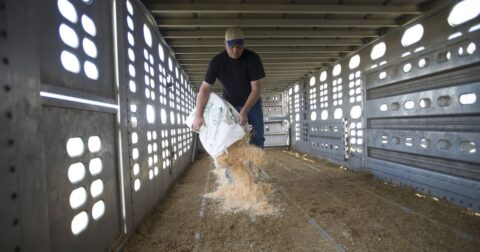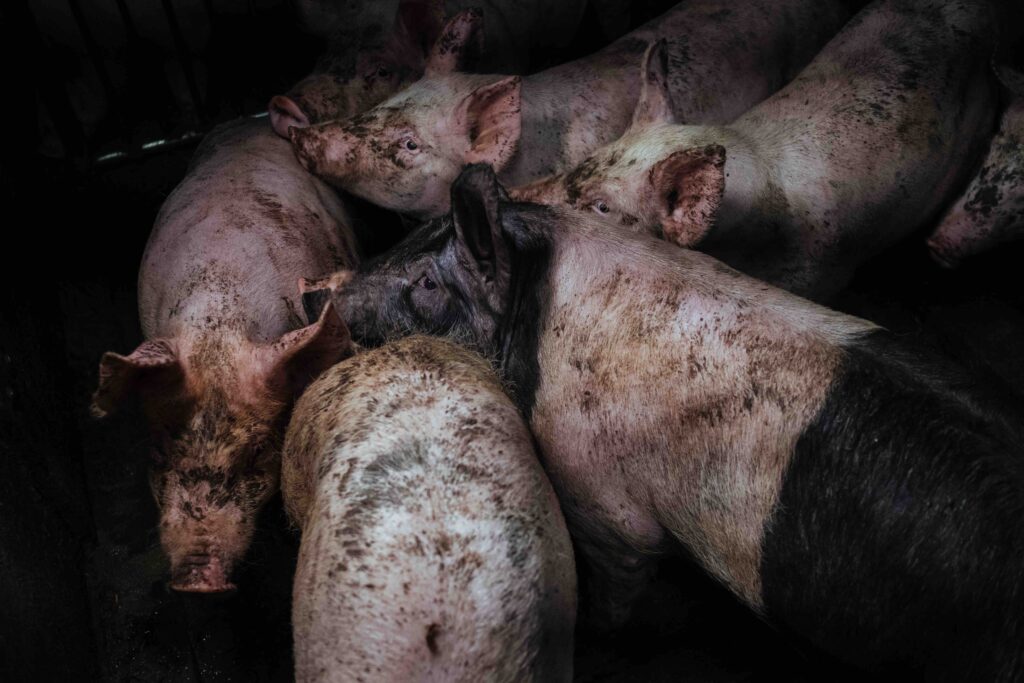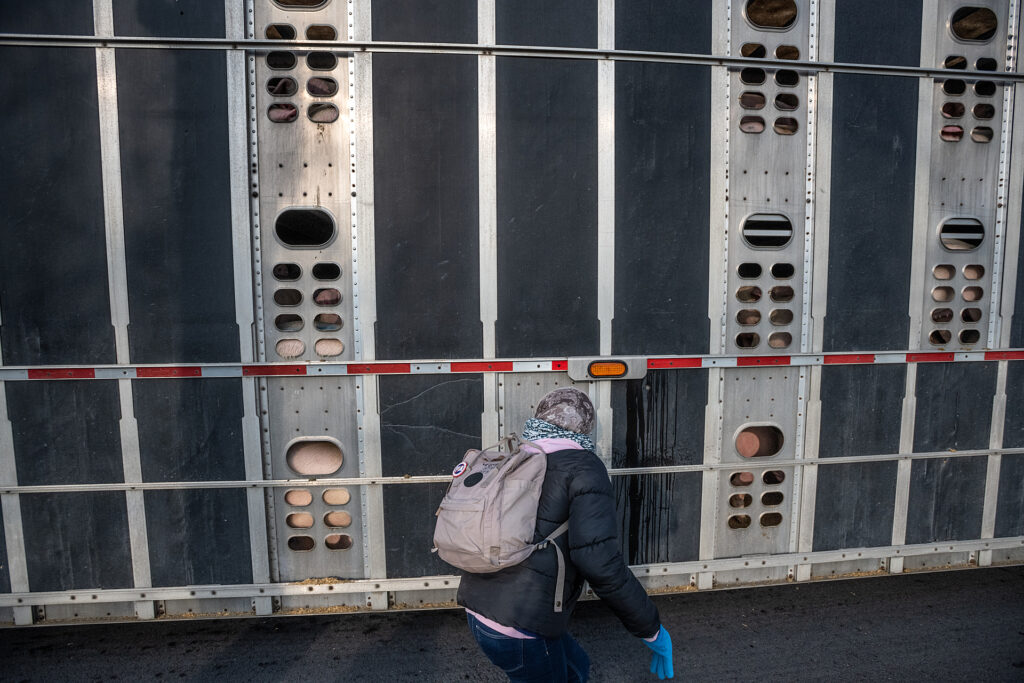News
Costco Chicken Processing Plant Keeps Failing Tests for Salmonella
Food•5 min read
Explainer
Over the past 50 years, mega-corporations have placed a firm hold on the pork industry, leaving many pig farmers in financial ruin.


Words by Hemi Kim
In the United States, about 2 percent of hogs are bought and sold the same way you might purchase a used cat carrier on Facebook Marketplace or eBay, in what is known as a negotiated transaction on the cash or “spot” market. The rest of the hogs are raised and sold by pig farmers under contract with a meatpacking company like Smithfield Foods or Tyson.
The payment for each hog is based on a special formula. This formula signifies something important: that people raising hogs for a living have almost no bargaining power in a marketplace where there are too few buyers. Hog producers often have just one buyer to sell to. For the pioneer of industrial pig farming Wendell Murphy, for example, that buyer is Smithfield. Just four multinational companies control about 70 percent of pork production in the U.S., per Civil Eats: JBS, Cargill, Smithfield, and Hormel.
As a result, over 50 years the price of pork paid to the pig farmer has been pushed down relative to the price that consumers pay for it. From 2015 to 2020, farmers’ earnings declined from 22.7 to 18.5 cents for every dollar a consumer spent on pork.
All the while, pork packing companies sit "quietly in the middle, generating record profits by the year,” writes Christopher Leonard in “Meat Racket.”
A pig farmer is someone who raises pigs for human consumption. Since 98 percent of pigs in the U.S. (and about 74 percent of farmed land animals globally) are raised on factory farms, the primary role of a pig farmer is to run a concentrated animal feeding operation (CAFO).
Pig farmers are also known as hog farmers. The terms pig and hog are interchangeable in this article, but typically pigs are smaller than hogs. Hogs are industry-sized animals.
Pig farmers are part of an industry that has segmented the raising of an animal into specialized farms: breeding and taking care of pregnant female pigs, farrowing (birthing baby pigs and weaning them), nursery (post-weaning period), and finishing (feeding hogs until they are ready to be slaughtered).
These farms can be large corporations that contain all of the stages it takes to raise pigs until they are slaughtered—making them almost like vertically integrated pork packers. The corporations can also form contracts with smaller pig farmers. These smaller farmers might focus on the farrowing through the finishing, the farrowing through nursery, or they might just focus on the finishing.
In 2019 most pig production in the U.S. (63 percent according to the USDA) was carried out under an exploitative contract based on the sharecropping model. In a production contract, the person raising the pigs does not own the pigs. The food company that owns the pigs pays the farmer based on the pigs’ weight and makes the farmer take on the expenses of maintaining and upgrading the land, equipment, and labor required to raise the pigs. Much of the remaining non-contract production of pigs is done in-house at packer-owned facilities.
Watch this video to learn more about the inadvisable business of swine contract work.
America’s Pig Farmer of the Year in 2017 was Leslie McCuiston, a “senior production manager for The Maschhoff’s, LLC. ” She was in charge of “70 employees who care for more than 18,000 sows.” Production managers like McCuiston might oversee and regularly visit several sow farms, as described in a 2015 Cultural Anthropology article by Alex Blanchette. Non-manager employees would typically be limited to working in one barn focusing on one phase of production, such as nursery. Another type of manager again might “travel across the distinct types of hog farms” and be responsible for their overall production.
Hog farmers at big companies will manage an entire herd of animals primarily using numbers and statistics. In one day, farmer-managers could oversee the different processes by which boar studs provide semen, baby pigs are born and weaned, and pigs are grown for meat.
Another type of hog farmer may take on the title of farmer without working directly with hogs or even managing a farm operation, according to a 2013 study of cooperative limited liability corporations (LLCs) in the Midwest, that have combined smaller farming operations into larger organizations with diffuse ownership and a more complex legal structure. In these cases the person calling themselves a farmer is typically investing in, or is a member of, an LLC or its subsidiary that manages mega-farms.
Such mega-farms may focus on breeding and weaning hogs that can then provide piglets for several finishing farms owned by their investors. Mega-farming operations can also manage the production of fertilizer from CAFOs. One problem with LLC-style farming is that it legally shields the faceless investors in CAFOs from liability and community oversight, and they no longer have the same personal responsibility or visibility over issues like pollution violations when using CAFO manure as fertilizer.
In the mega-farm model, farmers own the hogs. The mega-farm provides the labor and management for every “phase of production,” including sales. In the finishing stage, the mega-farm provides hog management as well.
A third hog farmer archetype is the family farm owner-operator. This farmer is more directly raising animals, usually under contract with a packing company or another hog-producing company. The swine contract farmer’s duties and responsibilities are dictated by the contractor, the company with whom they are contracted to serve. Because the contractor is usually a vertically integrated company, the contract farmer is often powerless and coerced into taking on too much debt.
To raise pigs, it is important for small, owner-operator farmers to know about pig nutrition and physiology, how to prepare and store pig feed, as well as “pig feeding and watering,” according to a 2021 report by the International Livestock Research Institute.
Swine managers may need to have a high school diploma or a college degree. They may even have a Ph.D. in nutrition or a veterinary degree, along with specific animal field research skills.
Swine managers enforce biosecurity measures to prevent the spread of disease, collaborate with multidisciplinary team members—including marketing, research, management, and sales—and closely monitor the animals in their care, among other responsibilities. Therefore it is important that they have strong communication, problem-solving, and leadership skills.
Whether they are at contract farms, farms owned by pork packers, or mega-farms, the threat of highly contagious diseases often requires hog farmers and laborers to follow strict rules to prevent the spread of germs from one group of pigs to another. These biosecurity rules may seep into one’s personal life. In addition to showering and changing into sanitized clothes before entering each facility, a farmer might also be expected to limit their social life outside of work to avoid cross-contamination with people who work in other hog facilities.
At contract farms, the call for protection of farmers against the exploits of multinational food companies is clear, but often ignored by the government: “I’ve been trapped in a contract for 26 years now. I’ve been made a lot of promises and few of those have been fulfilled. We’ve made numerous efforts to improve the situation for contract producers,” says Tom Butler, a contract swine farmer in North Carolina, according to a RAFI-USA press release.

Agricultural work is “dirty, dangerous, and demanding,” per a 2016 report in Safety. Being a farmer means overseeing an environment in which workers can experience hearing loss, respiratory problems, and often report “irritation of the eyes, nose, throat, and headaches” due to toxins in the environment. Physical injuries are also common.
Pig farming is a seven-day-per-week operation, often requiring long hours. For example, to attend a 5 a.m. semen collection at a boar stud farm, managers were on the road at 3:30 a.m., in a 2015 observation of the field. In a public testimony in support of a cooperative LLC, Ron Fowler stated that he was tired of “coming home at about 7 or 8:00 at night most nights,” according to researchers in 2013.
Hog farmers in the U.S. earned a median net income of $19,318 per year in 2019, and nearly half that amount the year prior for the same metric ($10,741), according to The Transfarmation Project and the USDA.
In 2017 there were 64,871 hog farms in the U.S. that sold 235.5 million hogs and pigs for $26.3 billion. Most of the sales of hogs were from concentrated animal feeding operations. Only 0.23 percent of sales came from farms with fewer than 50 hogs.
The National Farmer’s Union estimated in September 2020 that per pound of pork, farmers were losing 53 cents, once production costs and payment prices were factored in.
In comparison, The Transfarmation Project reported that the 2019 median net income of cattle farmers was -$370, and of poultry farmers was $17,862. Nearly half (47.6 percent) of all hog farmers and 41 percent of poultry farmers had debt, roughly double the rate of indebted cattle farmers in 2019 (23.4 percent).

Pig farming is harmful to the environment, and to human and animal health. For example, the odors from CAFOs not only smell bad, but they also pollute the air with ammonia, hydrogen sulfide, “volatile organic compounds, particulate matter, and endotoxins commonly found in CAFOs,” according to a 2016 Safety report. The mostly Latino immigrant laborers who run hog farms are often neither trained nor supported in ways of protecting themselves from such environmental pollutants, like using earplugs, face masks, and safety goggles.
Pig farmers have historically over-relied on antibiotics to grow animals, which has led to antimicrobial resistance and the rise of superbugs that threaten human and pig health.
The role of a pig farmer can be that of a manager who oversees employees and technocratically tends to the needs of immense groups of hogs. Sometimes pig farmers are using the title and public image of a family farmer as they become investors in opaque corporations that run CAFOs, and manage predominantly immigrant laborers in other states. Many are owner-operators who work directly with the animals and alongside their low-paid laborers.
Running a pig farm that supplies the materials for popular and affordable products like bacon or gelatin is a punishing, dangerous and dirty job. Environmental pollution, harms to neighboring communities, and animal welfare concerns are constant stressors in a career in pig farming. Finally, the increasing economic power of multinational pork packers has made it increasingly difficult for independent and contract pig farmers to survive.